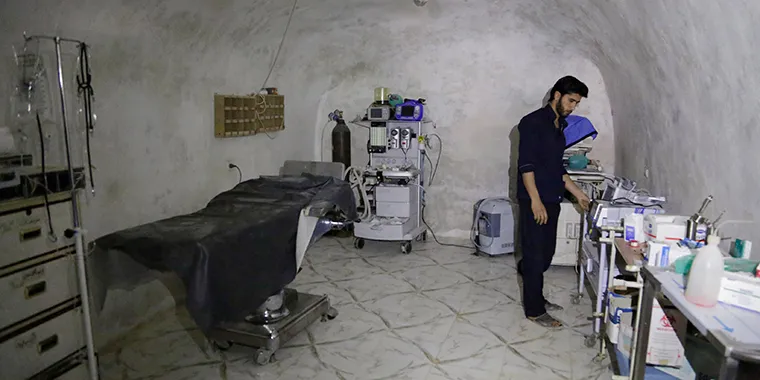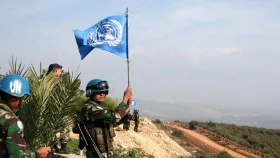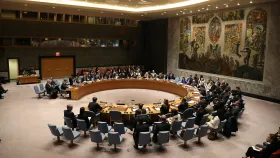In 1861, journalists, politicians, and their families set up picnics to watch the first land battle of the American Civil War. The onlookers expected the fighting to be quick, relatively bloodless, and—perhaps most important—safe to observe.
Those assumptions were not exactly accurate; the ensuing fighting sent soldiers and spectators alike scrambling.
But those assumptions were also not entirely unfounded. Many wars at the time were confined to the battlefield, and, indeed, soldiers—not civilians—would end up composing most of the Civil War’s casualties.
However, wars in recent decades have become increasingly deadly for civilians. Civilian casualties outnumbered battlefield deaths during World War II, as combatants bombed major cities. Between 1990 and 2000, civilians accounted for 90 percent [PDF] of the world’s four million war-related deaths.
This resource explores the various threats facing civilians in today’s conflicts and their devastating consequences, which linger long after the final bomb has fallen.
Casualties from direct violence
Over the past century, fighting has increasingly shifted [PDF] from remote battlefields to densely populated cities. As a result, civilians are exposed to greater risk.
During World War II, the combatants waged “total war,” bombing population centers such as London, Paris, and Tokyo. This type of warfare led to the deaths of tens of thousands of civilians. After the war, colonial powers fought opposition groups and independence movements in cities in Algeria, Kenya, and Vietnam. In those instances, colonial powers conducted urban warfare to target guerrilla fighters who often attempted to blend in with civilian populations. More recently, wars in Iraq and Syria have leveled entire cities, resulting in the deaths of hundreds of thousands of civilians and the displacement of millions more. For almost every year in the past decade, civilians have accounted for over 90 percent of casualties when explosive weapons were used in populated areas.
Recent conflict in Israel and Palestine after an attack on Israel on October 7 by Hamas is yet another grim reminder of the many civilian consequences of war. According to the Armed Conflict Location & Event Data Project, over 1,300 people were estimated to have been killed in the first three days of fighting starting on October 7. These included 800 Israelis and 500 Palestinians.
Violent conflict in the region started long before this most recent war. According to the United Nations, some 6,400 Palestinians and 300 Israelis had been killed since 2008 before the newest conflict erupted in October 2023. Decades of armed conflict in the region have led to the violent loss of civilian lives on all sides. The fallout from the relentless human devastation has provided fodder for continued tensions and fighting.
Wars of all kinds have civilian costs. Sometimes these result not only from unintended collateral damage but from direct assaults on civilians as a tool of war—seen in everything from the bombing of hospitals and schools in efforts to advance political gains to hostage-taking and beyond. In more than one hundred civil wars between 1989 and 2010, almost 50 percent of government forces and 60 percent of rebel groups deliberately attacked civilians. Combatants often target civilians to gain territory or punish populations loyal to the enemy. Terrorists carry out some of the most visible acts of civilian targeting to advance their political or ideological objectives.
Determining precise civilian casualty counts is notoriously difficult in conflict zones. The chaos of combat and the fact that combatants often do not wear uniforms prevent accurate recordkeeping of civilian casualties. The Barack Obama administration in the United States, for example, essentially considered all males sixteen and older in a drone strike zone to be combatants. Because of that policy, the administration concluded that it had not killed a single civilian in a year of strikes. Independent organizations tallied hundreds of civilian deaths throughout the same period. Given such factors, civilian deaths have historically been underreported or gone uncounted altogether.
Casualties from indirect violence
Not all civilian casualties result from direct violence. Many deaths stem from indirect causes, including war-induced poverty, hunger, and medical shortages.
Death rates surge when civilians lack access to reliable medical care. In Syria, Russian fighter jets have bombed hospitals so frequently that healthcare workers have resorted to moving their facilities into reinforced basements and caves. Even those facilities have been targeted by bunker-buster bombs. The destruction of the country’s healthcare system has contributed in part to a decline in Syria’s average life expectancy by as much as twenty years.
Conflict also exacerbates food insecurity. In 2019, ten out of the world’s thirteen most urgent food crises were in conflict zones. Grocery stores in conflict-affected countries often have empty shelves. What limited supplies do exist are often prohibitively expensive. In many cases, a meal can cost more than a day’s wages. The cost of a plate of bean stew in South Sudan, where civil war has raged since 2013, is equivalent to $348 in New York. As a result, nearly half a billion people go hungry in conflict zones.
Additionally, conflict often leads to dramatic increases in sexual violence—a problem that disproportionately affects women. For example, between 100,000 and 250,000 women were raped during the three months of the Rwandan genocide in 1994. The breakdown of traditional security structures plays a major role in conflict-affected areas experiencing higher rates of rape, assault, intimate partner violence, and trafficking.
Conflict’s long-lasting effects
Philosopher George Santayana once wrote, “Only the dead have seen the end of war.” For even after the bullets stop flying, civilians face enormous challenges trying to rebuild their neighborhoods, economies, and lives.
Trauma persists well after conflict ends. One in five people living in active or recent war zones has depression, anxiety, post-traumatic stress disorder (PTSD), bipolar disorder, or schizophrenia. Trauma-induced mental health problems can even be passed down generations. Children of conflict survivors can experience higher rates of PTSD and anxiety disorders.
Further, conflict causes profound economic pain, including $1 trillion in worldwide economic losses in 2016. That translates into communities losing schools, factories, roads, hospitals, and more—all of which makes economic recovery more difficult.
Cambodia’s communist Khmer Rouge regime, for instance, destroyed 90 percent of the country’s schools between 1975 and 1979. As a result, Cambodians lost years of education; a 2001 survey showed that 20 percent of adults had never received any schooling. Limited educational attainment contributed to decades of poverty for many Cambodians.
Conflict can also displace entire communities. The process of displacement takes place when people in conflict zones are forced to evacuate their homes and seek asylum in stable, neighboring countries. By the end of 2019, nearly eighty million people had fled their homes—the highest number since World War II. That forced movement presents enormous challenges, not just for the displaced people but also for those communities suddenly providing food, housing, and jobs for thousands or even millions of new residents. Bangladesh, for example, announced in March 2019 that it would no longer accept refugees, after admitting over seven hundred thousand Rohingya Muslims fleeing genocide in neighboring Myanmar.
In today’s increasingly interconnected world, conflict rarely stays local. Whether it is refugees crossing borders, infectious diseases spreading uncontrolled into neighboring countries, or terrorists capitalizing on instability to plot attacks abroad, conflict can begin locally, but its consequences are rarely contained to a battlefield.



